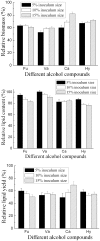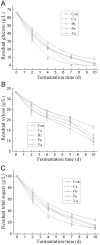Effects of alcohol compounds on the growth and lipid accumulation of oleaginous yeast Trichosporon fermentans
- PMID: 23071683
- PMCID: PMC3465294
- DOI: 10.1371/journal.pone.0046975
Effects of alcohol compounds on the growth and lipid accumulation of oleaginous yeast Trichosporon fermentans
Abstract
The inhibitors present in dilute acid-treated lignocellulosic hydrolysates would show great effect on the growth and product formation of microorganisms. To understand their inhibitory law and mechanism on oleaginous microorganism could help improving the efficiency of lignocellulose hydrolysis, detoxification, and lipid fermentation. The effects of four representative alcohol compounds present in lignocellulosic hydrolysates, including furfuryl alcohol, vanillyl alcohol, catechol, hydroquinone on the cell growth and lipid accumulation of Trichosporon fermentans were systematically investigated in this work. The toxicity of selected alcohol compounds was well related to their log P value except furfuryl alcohol, whose log P value was the minimum but with the highest toxicity to T. fermentans. The inhibition of all the alcohol compounds on the growth of T. fermentans was more serious than on the lipid synthesis. Also, the growth of T. fermentans was more sensitive to the variation of inoculum size, temperature, and initial pH than lipid synthesis in the presence of alcohol compounds. Initial pH had more profound influence on the lipid fermentation than inoculum size and cultural temperature did. Careful control of fermentation conditions could be helpful for improving lipid yield of T. fermentans in lignocellulosic hydrolysates. Among the four alcohol compounds tested, most alcohol compounds showed inhibition on both sugar consumption and malic enzyme activity of T. fermentans. However, vanillyl alcohol had little influence on the malic enzyme activity. Similarly, all alcohol compounds except vanillyl alcohol exerted damage on the cell membrane of T. fermentans.
Conflict of interest statement
Figures








Similar articles
-
Effects of aldehydes on the growth and lipid accumulation of oleaginous yeast Trichosporon fermentans.J Agric Food Chem. 2011 May 11;59(9):4606-13. doi: 10.1021/jf104320b. Epub 2011 Apr 11. J Agric Food Chem. 2011. PMID: 21443267
-
In vivo detoxification of furfural during lipid production by the oleaginous yeast Trichosporon fermentans.Biotechnol Lett. 2012 Sep;34(9):1637-42. doi: 10.1007/s10529-012-0948-x. Epub 2012 May 22. Biotechnol Lett. 2012. PMID: 22648683
-
Effect of organic acids on the growth and lipid accumulation of oleaginous yeast Trichosporon fermentans.Biotechnol Biofuels. 2012 Jan 19;5:4. doi: 10.1186/1754-6834-5-4. Biotechnol Biofuels. 2012. PMID: 22260291 Free PMC article.
-
Biotechnological strategies to overcome inhibitors in lignocellulose hydrolysates for ethanol production: review.Crit Rev Biotechnol. 2011 Mar;31(1):20-31. doi: 10.3109/07388551003757816. Epub 2010 May 31. Crit Rev Biotechnol. 2011. PMID: 20513164 Review.
-
Alternatives for detoxification of diluted-acid lignocellulosic hydrolyzates for use in fermentative processes: a review.Bioresour Technol. 2004 May;93(1):1-10. doi: 10.1016/j.biortech.2003.10.005. Bioresour Technol. 2004. PMID: 14987714 Review.
Cited by
-
Comparative proteomics profile of lipid-cumulating oleaginous yeast: an iTRAQ-coupled 2-D LC-MS/MS analysis.PLoS One. 2013 Dec 26;8(12):e85532. doi: 10.1371/journal.pone.0085532. eCollection 2013. PLoS One. 2013. PMID: 24386479 Free PMC article.
-
Engineering the oleaginous yeast Yarrowia lipolytica to produce limonene from waste cooking oil.Biotechnol Biofuels. 2019 Oct 8;12:241. doi: 10.1186/s13068-019-1580-y. eCollection 2019. Biotechnol Biofuels. 2019. PMID: 31624503 Free PMC article.
-
Development of a phenotypic assay for characterisation of ethanologenic yeast strain sensitivity to inhibitors released from lignocellulosic feedstocks.J Ind Microbiol Biotechnol. 2014 Jun;41(6):931-45. doi: 10.1007/s10295-014-1431-6. Epub 2014 Mar 25. J Ind Microbiol Biotechnol. 2014. PMID: 24664516
-
Mechanistic insights into the effect of imidazolium ionic liquid on lipid production by Geotrichum fermentans.Biotechnol Biofuels. 2016 Dec 16;9:266. doi: 10.1186/s13068-016-0682-z. eCollection 2016. Biotechnol Biofuels. 2016. PMID: 28018484 Free PMC article.
References
-
- Demirbas A (2009) Progress and recent trends in biodiesel fuels. Energy Convers Manage 50: 14–34.
-
- Adamczak M, Bornscheuer UT, Bednarski W (2009) The application of biotechnological methods for the synthesis of biodiesel. Eur J Lipid Sci Technol 111: 800–813.
-
- Meng X, Yang JM, Xu X, Zhang L, Nie QJ, et al. (2009) Biodiesel production from oleaginous microorganisms. Renew Energ 34: 1–5.
-
- Li Q, Du W, Liu DH (2008) Perspectives of microbial oils for biodiesel production. Appl Microbiol Biotechnol 80: 749–756. - PubMed
-
- Huang C, Zong MH, Wu H, Liu QP (2009) Microbial oil production from rice straw hydrolysate by Trichosporon fermentans . Bioresour Technol 100: 4535–4538. - PubMed
Publication types
MeSH terms
Substances
LinkOut - more resources
Full Text Sources
Other Literature Sources

